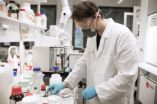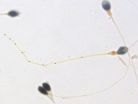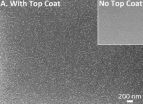(Press-News.org) Big fish that have grown up in marine reserves don't seem to know enough to avoid fishers armed with spear guns waiting outside the reserve.
The latest research by an Australian team working in the Philippines into the effects of marine reserves has found there is an unexpected windfall awaiting fishers who obey the rules and respect reserve boundaries – in the form of big, innocent fish wandering out of the reserve.
"There are plenty of reports of fish, both adults and juveniles, moving out of reserves and into the surrounding sea. Having grown up in an area where they were protected from hunting, we wondered how naïve they would be with regard to avoiding danger from humans," says Fraser Januchowski-Hartley of the ARC Centre of Excellence for Coral Reef Studies.
The answer is: pretty naïve. "Educated fish normally turn tail and flee when a diver armed with a spear gun approaches within firing range of them. The typical flight distance is usually just over four metres," he explains.
"However in our studies of marine reserves in the Philippines, Vanuatu and Papua New Guinea, where spearfishing remains a major way of harvesting table fish, we discovered that reserve-reared fish were much less wary and allowed people to get much closer.
"The fish are literally more catchable."
The team studied fish across the boundaries of marine reserves from 200m inside the protected areas to 200m into the fished areas. They used underwater markers and measuring tapes to measure the 'flight initiation distance' of fish targeted locally by spearfishers. This indicates how close a skin diver can approach to a large fish before it decides to turn and flee.
They found that target fish living in fished areas were typically much warier of divers, and took flight at distances a metre or two further away, than ones living within the reserve.
They also established that the 'naivete radius', whereby more catchable fishes spill out of the marine reserves extended for at least 150 metres from the boundary.
The team's findings suggest that fishers are more likely to catch fish that stray out of the reserve, and so improve the local fish harvest. This may help fishers become more supportive of marine reserves.
"In these parts of the oceans, spear fishing is still very much about survival for humans and putting food on the family table – so it is important that local fishers feel they are deriving some benefit from having a local area that is closed to fishing, or they may not respect it," says Dr Nick Graham, a co-author on the study.
"This information is also useful in traditional reserves where fishing is taboo most of the time, but then they are opened for fishing by village elders just a few days a year.
"On the face of it, this work suggests that marine reserves can play an important role in putting more fish on the table of local communities in these tropical locations – as well as conserving overall fish stocks and replenishing those outside the reserve," Januchowski-Hartley says.
###
The team's paper 'Spillover of fish naïveté from marine reserves' by Fraser A. Januchowski-Hartley, Nicholas A. J. Graham, Joshua E. Cinner and Garry R. Russ appears in the latest issue of the scientific journal Ecology Letters. http://doi.wiley.com/10.1111/ele.12028
More information:
Nick Graham, JCU and CoECRS, ph +61 (0)7 4781 6291 or 0466432188
Fraser Januchowski-Hartley, CoECRS, ph +1 608 807 1202
Jenny Lappin, CoECRS, +61 (0)7 4781 4222
Jim O'Brien, James Cook University Media Office, +61 (0)7 4781 4822 or 0418 892449
http://www.coralcoe.org.au/
Naïve fish: Easy targets for spear fishers
2012-11-13
ELSE PRESS RELEASES FROM THIS DATE:
A safer porn policy for employers
2012-11-13
Employers must have in place a strict policy regarding pornography in the workplace if they are to avoid legal action from sexual harassment and discrimination charges, according to a study by Craig Cameron of the Griffith University. Writing in the International Journal of Technology Policy and Law, Cameron identified five primary methods of what he refers to as pornography participation that require specific policies to protect both employer and employee in almost any jurisdiction.
According to Cameron, technology has allowed pornography to infiltrate the workplace, ...
Principal plays surprising role in why new teachers quit
2012-11-13
EAST LANSING, Mich. — Why do so many beginning teachers quit the profession or change schools? Surprising new research finds it's not a heavy workload or lack of resources that has the most significant effect, but instead the relationship between teachers and their principal.
Peter Youngs, associate professor of educational policy at Michigan State University and lead investigator on the study, said the findings reinforce the need for principals to serve as strong, supportive leaders in their schools.
"The principal isn't there just to help the novice teacher handle ...
Extinct or passé? New research examines the term, 'metrosexual'
2012-11-13
Did the "metrosexual" male die out with the last decade, or has he become the new normal? Erynn Masi de Casanova, a UC assistant professor of sociology, will present her research about the label on Nov. 14, at the 111th annual meeting of the American Anthropological Association in San Francisco.
Casanova's research, based on interviews with men in three major metropolitan cities, found that men in general were taking more interest in a well-groomed appearance and that they felt the term, "metrosexual," was a stereotype that had run its course.
Some men who were interviewed ...
Researchers have made the production of batteries cheaper and safer
2012-11-13
Researchers at Aalto University, Finland have developed a method for producing lithium batteries that is cheaper and more environmentally friendly than previously used methods. This new process has succeeded in replacing the harmful methylpyrrolidone (NMP) solvent, which is traditionally used in the manufacturing of electrodes, with water. Removing this harmful solvent from the production process makes the production of batteries simpler and safer for employees. Production costs of batteries can be decreased by as much as 5 percent. Some of this savings comes from the reduced ...
Second most common infection in the US proving harder to treat with current antibiotics
2012-11-13
Washington, D.C.— Certain types of bacteria responsible for causing urinary tract infections (UTIs), the second-most-common infection in the United States, are becoming more difficult to treat with current antibiotics, according to new research from Extending the Cure (ETC), a project of the Center for Disease Dynamics, Economics & Policy. ETC released the research via its online ResistanceMap, an online tool created to track changes in antibiotic drug use and resistance. This year, ResistanceMap features analysis using ETC's Drug Resistance Index, a way for non-experts ...
Scientists discover how stomach cancer spreads
2012-11-13
Scientists at the University of Liverpool have found that the production of a protein that prevents the growth and spread of cancerous cells is impaired in patients with gastric cancer.
Cancer of the stomach is the second most common cause of death due to malignant disease worldwide. New research findings at Liverpool, however, could contribute to the development of future gastric cancer therapies by restoring the functions of a protein called, TGFβig-h3.
The protein is released by cells called myofibroblasts, which form part of the supporting tissue around cancer ...
How do cells tell time? Scientists develop single-cell imaging to watch the cell clock
2012-11-13
COLUMBUS, Ohio – A new way to visualize single-cell activity in living zebrafish embryos has allowed scientists to clarify how cells line up in the right place at the right time to receive signals about the next phase of their life.
Scientists developed the imaging tool in single living cells by fusing a protein defining the cells' cyclical behavior to a yellow fluorescent protein that allows for visualization. Zebrafish embryos are already transparent, but with this closer microscopic look at the earliest stages of life, the researchers have answered two long-standing ...
Powering lasers through heat
2012-11-13
This press release is available in German.
Since its invention 50 years ago, laser light has conquered our daily life. Lasers of varying wave lengths and power are used in many parts of our life, from consumer electronics to telecommunication and medicine. However, not all wave lengths have been equally well researched. For the far infrared and terahertz regime quantum cascade lasers are the most important source of coherent radiation. Light amplification in such a cascade laser is achieved through a repeated pattern of specifically designed semi-conductor layers of ...
Sperm length variation is not a good sign for fertility
2012-11-13
PROVIDENCE, R.I. [Brown University] — Perhaps variety is the very spice of life, but as a matter of producing human life, it could be the bane of existence. That's the indication of a new study in the journal Human Reproduction that found men with wider variation in sperm length, particularly in the flagellum, had lower concentrations of sperm that could swim well. Those with more consistently made sperm seemed to have more capable ones.
"Our study reveals that men who produce higher concentrations of competent swimming sperm also demonstrate less variation in the size ...
Computer memory could increase fivefold from advances in self-assembling polymers
2012-11-13
AUSTIN, Texas — The storage capacity of hard disk drives could increase by a factor of five thanks to processes developed by chemists and engineers at The University of Texas at Austin.
The researchers' technique, which relies on self-organizing substances known as block copolymers, was described this week in an article in Science. It's also being given a real-world test run in collaboration with HGST, one of the world's leading innovators in disk drives.
"In the last few decades there's been a steady, exponential increase in the amount of information that can be stored ...




